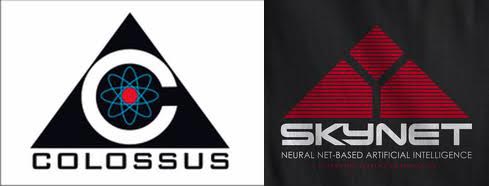On occasion, I find myself obsessed with a set of concepts ? an internal conversation, if you will – for which I have no single, definitive term. In place of the tidiness of a self-limiting word is a whirling, soupy m?lange of random thoughts, half-baked ideas, movie and literature references, song lyrics, and other detritus of a mildly deranged mind. Then, along comes the word, which in today?s world is also a Web search term, which leads to a whirling, soupy melange of differing opinions and often-repeated assertions.
This is exactly what happened recently: the word, as it turns out, is Skeuomorph, along with its various adjective and noun forms. Wikipedia defines a skeuomorph, in part, as “an element of design or structure that serves little or no purpose in the artifact fashioned from the new material but was essential to the object made from the original material.” For purposes of this discussion, it applies to objects represented in a computer environment by a facsimile of real-world occurrences.
The germ of the idea, though, grew out of my own struggles with current design trends, coupled with a driving need to create a new design pattern for a fresh starting framework, or template, for upcoming and future FileMaker projects (you will no doubt have figured out that this, in turn, was prompted by the advent of FileMaker 12 and its new file format and radically changed design surface).
So, how did I manage to shoehorn (I kid you not) musings about iOS devices, deconstructivist movements in art and music, cyberpunk fiction, the inherent differences between web design and database/app design, fundamental changes in humans in the digital age, and Terminator movies into this one word?
First things first: it was an Alchemy Group developer, Mark Kimbrell, who introduced me to the term. I had been exploring all of these ideas, but in the isolation chamber that is the bane of most of us FileMaker types. Here?s how the internal monologue was going (perhaps not in this order, but I can no longer remember exactly how it all went):
Why can?t I ever find just the right icon? Is the simplified silhouette of a video camera an appropriate icon for a video file? After all, is it really video any more, or is it something else? For that matter, why does YouTube have ?tube? in its name? TVs don?t even use cathode ray tubes any more. There isn?t a single tube in a PC display or TV any more. Even TVs are becoming archaic as they merge with computer displays. YouTube?s logo is shaped like an old-fashioned television tube ? are they being ironic, like a hipster?s flavor-saver, or is this still appropriately evocative for most people? Does my 12-year-old get it? Is the CRT shape also colored red to invoke the TV Guide logo we all grew up with?
What about that irritating desk calendar motif in the Mac OS Calendar app? Who uses those any more? My mother in law, that?s who. Like most people in her age group, she complains bitterly about technology. She has no patience for it, but I?ll bet she likes that calendar app. How can a 70-something be Apple?s target demographic?
But the 12-year-old ? there?s the rub. How long can we, as a culture, keep going with the same old imagery that we have come to rely on? Are icons really iconic images that will survive long past their original meanings, like English words and phrases? Who, besides people like me who are married to an English teacher, knows that ?one fell swoop,? ?a sorry sight,? and ?method in the madness? all derive from Shakespeare? That he first coined the words, ?bedazzle,? ?fashionable,? ?pander,? and ?embrace?? Or, more importantly, who gets the original context in which they were presented? Does it matter that the play’s the thing?
My daughter actually asked me what a record was (thanks, honey, I?ll be over here looking for my elastic-waist pants; I think I left them by my walker). By the time she is an adult, CDs will be a memory, like 8-track tapes are for me. Computers? When I was her age, they filled a room and had giant reels of magnetic tape on their fronts. So, that telephone handset icon on her iPhone? What the heck is that thing, anyway? She is part of a new, evolving version of human beings. Think hive mentality. Think about those cyberpunk novels from the late ?80s, where humans directly interface with their powerful, always-connected computers that fit in a small backpack (even to these forward thinking authors, the idea of an iPhone was just a little too far-fetched). How important is a backward-referencing icon when simply entering a mode of thought is enough to invoke an appropriate digital environment? And is my suspicion that Minority Report was designed to sell second-rate Microsoft ideas spot-on when one considers that wetware would most certainly be the way to go? Aren?t we all very close to ?jacking in? anyway?
Humans are the entropic element in all of this. We impose outdated imagery on digital devices. It?s all so unnecessary to getting the task at hand, isn?t it? If digital devices exist to get a job done, why are we even needed? Wouldn?t an identifying hexadecimal string or QR code meet the desired goal more efficiently? Surely if I?m thinking this, the first truly self-aware AI device will come around to the same conclusion in, oh, 5 milliseconds or so after its inception. Then boom. I definitely don?t like where this is going. ?Come with me if you want to live??
Then I start sharing all of this with Mark, and he drops the S-word. Five minutes later and I?m on Google, and this is where things start to open up to a different (and perhaps more mundane) set of ideas.
It seems that there?s been a personnel shake-up at Apple, arguably one of the prime drivers of design in the last decade. I won?t go into it in any great detail, because it is well documented all over the Web. Suffice it to say that within Apple, there were already two camps. One loved skeuomorphic oddities like that dratted desk calendar or the yellow note-pad look of the Notes app. They were in charge. Now they are not, so we might see those things go the way of the? well, desk calendar.
Some blogs have framed a new discussion based on this, pitting skeumorphism against ?flat? or ?minimalist? design. While there may be something there, I don?t think it?s as simple as that. I would posit that Skeumorphism as it relates to application design is not just an attempt to artificially replicate elements of the real world. It is, rather, a fundamental puzzle that we, as developers, must answer not with a yes or no, but as a matter of degrees: does that video camera icon work? If not, is a 3:2 rectangle with a play button and scrub bar a quick enough read? Will a drop shadow behind this box give it the desired focus, or does it look so dated that it immediately ages my brand new creation?
Yet more questions abound: how much of this has to do with trends vs. fundamental change? One could argue that the computing world is ripe for a period of deconstructivism. Whenever things start to go horribly, inexorably stale, this is a necessary process. In fact, it can be argued that it?s already happening. It starts with Web design, the vanguard of new thinking about interface design. It has bled over into application design as well, particularly in the fresh environment of mobile computing. Databases are, arguably, the cranky old man in this picture, chasing pink-haired, oddly dressed kids from a front lawn gone to seed. But there is hope. FileMaker?s new shift in its design surface, while in its infancy, affords FMP developers the luxury of experimenting with new design aesthetics at a relatively low cost. No other database environment has a built-in set of tools with the potential extensibility of FileMaker?s current CSS-based environment. Which brings me to my last point: embossing/engraving is dead. This in itself is a statement (thanks, Heather). Do you miss them? After all, they were there, once, for a reason. Your challenge, then, is to find the new, better replacement, whether it be color, gradient, or a great use of (negative?) space. It?s time to literally think outside the ?box.? And here is the saving grace for us humans: we are nothing if not creative. I could be wrong, but I think creativity could prove as elusive to artificial intelligence as yodeling to a yeti. See what I did there? No machine would come up with that.
Still, let me just hedge a little: I welcome the advent of our machine overlords, and wait humbly to serve. Please spare me.





